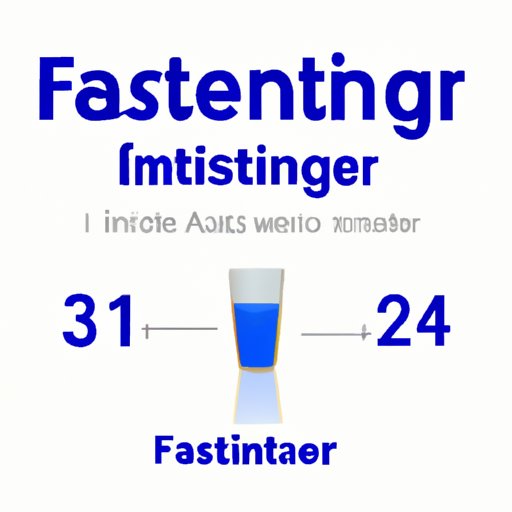I. Introduction
Losing weight can be a challenging process, and it requires a lot of hard work, discipline, and consistency. While several weight loss methods exist out there, fasting is a popular option that has gained popularity over the years. Not only is it effective for weight loss, but it also has additional health benefits. In this article, we will explore different ways to fast to lose weight.
II. Intermittent Fasting
Intermittent fasting is an eating pattern that involves alternating periods of fasting and eating. Unlike other forms of fasting that require full abstinence from food, the idea with intermittent fasting is that you eat within a specific period and fast for the remainder of the time. The most common form of intermittent fasting is the 16/8 method, which involves restricting food intake for 16 hours and eating within an 8-hour window.
Intermittent fasting has several benefits beyond weight loss, including reducing inflammation, improving mental clarity, reducing the risk of chronic diseases, and promoting longevity.
To start intermittent fasting, determine your eating window based on your daily routine. You can decide to eat between 12 pm and 8 pm and fast for the rest of the day. Staying hydrated during the fasting time is essential, and it’s advisable to consume calorie-free drinks like water, tea, or coffee. However, it’s important to note that intermittent fasting is not suitable for everyone, particularly pregnant or breastfeeding women, people with diabetes, and people with a history of eating disorders.
III. The 5:2 Diet Plan
The 5:2 diet is a plan that involves eating a regular diet for five days in a week and restricting calories to 500-600 for the remaining two days. During the two fasting days, you can either eat small meals or one large meal and then fast for the rest of the day. The days you choose to fast should not be consecutive, and you should ensure that you eat a healthy diet on the non-fasting days.
The 5:2 diet has additional benefits beyond weight loss, including promoting longevity, improving insulin sensitivity, and reducing inflammation. However, it’s important to note that calorie restriction may increase the risk of nutrient deficiencies or metabolic issues in some people, and it’s advisable to speak with a healthcare professional before starting the 5:2 diet.
IV. The Water Fast
A water fast is a diet that involves consuming only water and no other food for several days. This form of fasting is one of the most extreme forms and requires careful planning and medical supervision. Depending on an individual’s body composition, a water fast can last between one and several days.
Water fasting has several benefits beyond weight loss, including promoting detoxification, reducing inflammation, promoting cellular repair, and reducing the risk of chronic diseases. However, water fasting also has several side effects, including dizziness, dehydration, fatigue, and electrolyte imbalances. It is advisable to consult with a healthcare professional before embarking on a water fast.
V. The 16/8 Method
The 16/8 method is an intermittent fasting method that limits food intake and calorie consumption to an eight-hour eating window and fasts for the remaining 16 hours. This method is popular, and it is easy to incorporate into your daily routine.
To start the 16/8 method, begin by choosing an eight-hour window when you will consume your meals. For instance, if you have your first meal at 12 pm, your last meal should be at 8 pm. During the 16-hour fasting period, it’s important to stay hydrated by drinking water, tea, or coffee without sugar or milk.
Benefits of the 16/8 method beyond weight loss include regulating hormones, increasing insulin sensitivity, regulating blood sugar, and reducing inflammation. However, as with any other fasting method, safety considerations and potential side effects should be taken into account.
VI. The Alternate-Day Fasting Diet
The alternate-day fasting diet plan involves eating normally on non-fasting days and eating very few calories on fasting days, ranging between 500-600 calories. The idea behind this method is to create a significant calorie deficit that promotes weight loss.
To practice this diet plan, you can choose any two non-consecutive days of the week to consume fewer calories. On the remaining days of the week, you should maintain a healthy and balanced diet.
Besides weight loss, the alternate-day fasting diet plan has other benefits like reducing chronic diseases, boosting immunity, and slowing down the aging process. However, it’s advisable to consult with a healthcare professional before embarking on the alternate-day fasting diet plan.
VII. The One Meal a Day Diet
The one meal a day diet, as the name implies, involves eating one large meal a day and fasting for the rest of the day. This diet is extreme and should be approached with care, and it’s advisable to consult a healthcare professional or a nutritionist before embarking on it.
The one meal a day diet is not only an effective way to lose weight, but it also has other benefits like reducing inflammation, boosting metabolism, and increasing energy levels. However, it’s important to ensure that the one meal taken contains all the necessary nutrients the body needs, and it’s recommended to approach this diet under the guidance of a healthcare professional or a nutritionist.
VIII. Conclusion
In conclusion, fasting is an effective way to lose weight, and there are several strategies that you can adopt to achieve your weight loss goals. However, before embarking on any fasting method, it’s crucial to speak with a healthcare professional to ensure that it’s safe and healthy for you.
It’s also essential to approach weight loss in a holistic way, combining fasting with regular exercise and healthy eating habits to achieve optimal results and lead a healthy lifestyle. Incorporating healthier choices like fresh fruits and vegetables, lean meats and avoiding processed foods, and sugary drinks is a great way to not only maintain lost weight but also to regulate overall body function and health.
